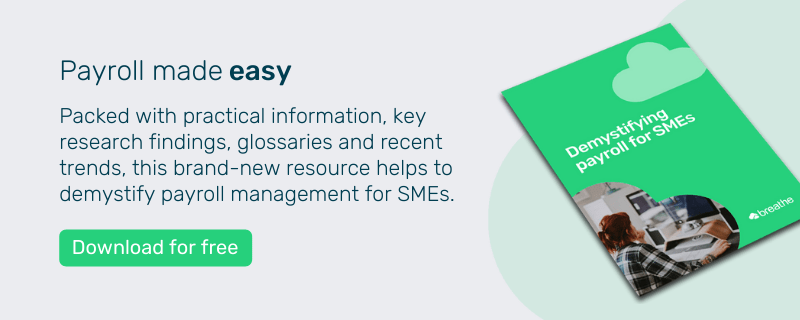These days, most organisations will either use dedicated payroll software to manage PAYE quickly and accurately or alternatively, outsource this important area of admin to an accountant or a dedicated bureau which specialises in this aspect of management. As a result, it is now entirely possible to manage payroll without knowing anything about the underlying calculations that determine payments and deductions based on employees’ circumstances.
But from time to time an employee may query a payment or deduction and it’s important to have some understanding of basic PAYE. In this article, we summarise the main points SME business leaders should be aware of.
Many businesses employ accountants, CFOs , managers and administrators that have specialist payroll knowledge and qualifications. Many smaller SMES may not have this in-house expertise – especially in their early days – and a basic grounding will help mitigate mistakes which could lead to queries and disputes. Understanding PAYE tax codes is one of the best places to start.
What PAYE tax codes mean
All PAYE tax codes are comprised of numbers and a letter, for instance, 1257L. This particular code is the most common in the UK and is used when has one job and pension.
The numbers in a PAYE tax code tells an employer or pension provider how much tax-free income an employee is entitled to in the current tax year. Each tax year begins on 6 April and ends on 5 April of the following year.
HMRC works out an employee’s individual number based on their tax-free Personal Allowance and income they have not paid tax on (such as untaxed part-time earnings).
HMRC also considers the value of any benefits from an employee’s job, such as a company car.
Current tax code letters
This is a list of the letters which form part of each tax code and what these mean. There are regional differences in the UK which apply to businesses and employees based in Scotland and Wales.
L - This indicates that an employee is entitled to the standard tax-free Personal Allowance
M - Marriage Allowance: an employee has received a transfer of 10% of their partner’s Personal Allowance
N - Marriage Allowance: an employee has transferred 10% of their Personal Allowance to your partner
T- An employee’s tax code includes other calculations to work out their Personal Allowance
0T- An employee’s Personal Allowance has been used up, they’ve started a new job and their employer does not have the details they need to provide the employee with a tax code
BR - When an employee’s income from a job or pension is taxed at the basic rate (usually used if they have more than one job or pension)
DO - When an employee’s income from a job or pension is taxed at the higher rate (usually used if they have more than one job or pension)
D1 - When an employee’s income from this job or pension is taxed at the additional rate (usually used if they have more than one job or pension)
NT- When an employee is not paying any tax on this income
S - This is used to indicate when an employee’s income or pension is taxed using the rates which apply in Scotland
SOT - When an employee’s Personal Allowance (Scotland) has been used up, or they have started a new job and their employer does not have the details they need to provide a tax code
SBR - When an employee’s income from a job or pension is taxed at the basic rate in Scotland (usually used when they have more than one job or pension)
SDO - When an employee’s income from this job or pension is taxed at the intermediate rate in Scotland (usually used if they have more than one job or pension)
SD1 - When an employee’s income from a job or pension is taxed at the higher rate in Scotland (usually used when they have more than one job or pension)
SD2- When an employee’s income from a job or pension is taxed at the top rate in Scotland (usually used when they have more than one job or pension)
C - When an employee’s income or pension is taxed using the rates which apply in Wales
COT - When an employee’s Personal Allowance (Wales) has been used up, or they have started a new job and their employer does not have the details they need to provide a tax code
CBR - When an employee’s income from this job or pension is taxed at the basic rate in Wales (usually used when the employs has more than one job or pension)
CD0 - When an employee’s income from a job or pension is taxed at the higher rate in Wales (usually used when the employee has more than one job or pension)
CD1 - When an employee’s income from a job or pension is taxed at the additional rate in Wales (usually used when an employee more than one job or pension)
Emergency tax
HMRC may apply an emergency tax code to an employee’s salary if it doesn't have enough details about how much tax they need to pay. This means an employee may miss out on tax-free allowances from which they would usually benefit.
Tax codes which end with ‘W1, ‘M1’ or ‘X’ indicate that an employee is, for the moment, paying emergency tax.
Employees usually find out they have been put on an emergency tax code is when they first begin working for a new company. Employees who join a company following a period of self-employment will be put on emergency tax until HMRC has collated information from any self-assessments (SA100s) which have been submitted to them in this or previous tax-years.
Depending on the information available, an employee will be charged at the basic rate (20%) or higher rate (40%) of tax on their entire pay packet, or just on their pay that exceeds the personal allowance. In 2021-22, this is £12,570. It was £12,500 in 2020-21.
Emergency tax codes are applied to an employee’s salary automatically by HMRC, but only as a temporary measure. Once HMRC has more information about how much an employee is earning, their tax code will be adjusted. The employee will then pay less tax.
Numbers in PAYE tax codes
The numbers in an employee's tax code show how much tax-free income they receive in a particular tax year. A payroll manager usually multiplies the number in the tax code by 10 to calculate the total amount of income they can earn before being taxed.
What does it mean in practise? Nearly everyone in the UK is entitled to a tax-free personal allowance, which means that a certain amount of their earnings each year are paid to them without being taxed. If your tax code was 1250L, it means your allowance was £12,500. An employee with a 1250L code will only pay tax on the amount they are paid over £12,500.
Income tax bands
Income tax bands help determine how much an employee is required to contribute based in their earnings.
These income tax bands apply to England, Wales and Northern Ireland for the 2022-23, 2021-22 and 2020-21 tax years. Income taxes in Scotland are different.
- Income up to £12,570 - 0% income tax. This is an employee’s personal tax-free allowance.
- Income between £12,571 and £50,270 - 20% income tax
- Income between £50,271 and £150,000 - 40% income tax
- Income above £150,001 - 45% income tax
An employee’s personal allowance will reduce by £1 for every £2 they earn over £100,000. So, by the time they earn, £125,000, they will pay income tax on everything they earn and receive no personal tax-free allowance.
Final thoughts
In this article we have scratched the surface of PAYE and specifically, the PAYE tax code element of this important area of financial management. There are many other factors such as secondary incomes from an employee’s hobby or property business for example. As an employer or payroll administrator, you also need to account for sick and maternity pay as part of your calculations.
The truth is, payroll management can be complicated and a time-consuming distraction for business leaders and managers who are attempting to establish and build their businesses. Understanding the basics is one thing, but the subject is complex. Investing in payroll software or outsourcing payroll management completely are options you may wish to consider to reduce your workload.
Many payroll systems have been designed specifically for people with no prior experience of the subject but who know how important it is to get PAYE management right from the first time they take on an employee. HMRC’s free basic tools are great for the reporting side of payroll management. HMRC also provide ample support via various online resources.
HMRC require SMEs to submit reports which including information about all payroll employment and deductions under the Real Time Reporting (RTI) scheme. For RTI reporting, you will need payroll software, or if you choose to outsource, your provider will need a system in place. HMRC publishes a list of payroll software options on their website and this is the starting place for many SMEs.
Payroll can be a headache and look daunting at the beginning support, tools and resources are there to help you tackle this area of business head-on from the moment you first set up PAYE.

Author: Aimée Brougham-Chandler
An IDM-certified Digital Copywriter (2023) & English Language & Literature graduate (BA Hons), Aimée is Breathe's Content Assistant. With 3 years' content marketing experience, Aimée has a passion for writing - and providing SME HR teams with solutions to their problems. She enjoys delving into & demystifying all things HR: from employee performance to health and wellbeing, leave to company culture & much more.
.webp)



